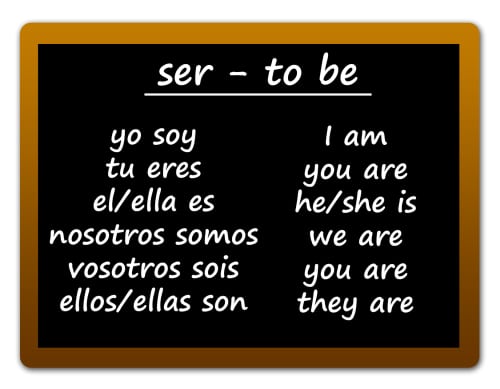5 Common Grammar Mistakes in Spanish
Learning grammar can be tiring, because of all the rules you have to follow. Even native speakers have some trouble with certain structures or words. But, at the same time, grammar is important to communicate properly. Even if you want to speak more than write, having a solid grammatical foundation will help you express yourself effectively, at work, with coworkers, or with your community.
Every language has its own challenges for English speakers. For the Spanish language, grammar is one of the most complicated, due to verb tenses, masculine/feminine words, and more. If you’re learning Spanish, you might be facing some difficulties and making some of these errors. Don’t be too hard on yourself! Just check these corrections on the 5 most common grammar mistakes in Spanish. Master these, and you’ll be speaking quite clearly.
1. Ser y Estar
For English speakers, the verb ‘to be’ (I am, you are, we are, etc) is one of the trickiest parts of the Spanish language, because it is split into two verbs: ser and estar.
SER is used to say that something or someone is/was a specific thing. I like to teach it to English speakers by explaining that this is who you are/what they are or the type of person you are/type of thing it is. For example:
- Él es divertido. – He is funny (person).
- Los zapatos son rojos. – The shoes are red (the type of shoes).
- Ella fue una bailarina. – She was a ballerina (who you are).
- Yo soy Maddy. – I am Maddy (who you are).
To express that something is or will be held at a specific place:
- La fiesta es en el parque. – The party is (being held) at the park.
To express time or quantity:
- Son las tres de la tarde. – It’s 3:00 pm.
- Ayer fue Viernes. – Yesterday was Friday.
- Son dos hermanos. – They are two brothers.
- Son cinco dólares. – It’s five dollars.
ESTAR is used to say that someone or something is/was at a specific place, or is/was doing something at a specific moment. So, it’s temporary:
- El perro está en el jardín. – The dog is (located currently) in the garden.
- Estuve en el museo. – I was (located) at the museum.
- Ella está bailando. – She is (currently) dancing.
If you can put located in, or currently in the sentence, then you are probably using the correct verb. It’s not fail-proof, but it’s pretty good.
It can also be used when something or someone is/was a specific thing at a specific moment, so it will change later:
- Los zapatos están limpios. – The shoes are (currently) clean. (They can get dirty – but aren’t now.)
2. Dequeísmo
This is a very common mistake, even among native Spanish speakers.
In Spanish, there are verbos prepositivos, which are verbs that need a preposition: contactar a, bailar con, quejarse de, etcetera.
Sometimes, people use the preposition “de” with a verb that doesn’t need it. When people make this mistake, the sentence has the conjunction “que”, and so they add a “de” between the verb and the “que”. That’s a dequeísmo. For example:
- Ella dijo de que no le gusta correr. – (She said that she doesn’t like running.) In that case, the verb “dijo” (said) doesn’t need “de”.
Tip: if you want to avoid the dequeísmo, change the sentence, starting from de “que”, for “eso” (that), that way you’ll see if it needs “de” or not. For example:
- Ella dijo de que no le gusta correr. = Ella dijo eso. (She said that).
You can see that the verb doesn’t need “de”. Or:
- Él se quejó de que la comida sabía mal. (He complained that the food tasted bad) = Él se quejó de eso. (He complained about that).
You can see that it is a verbo prepositivo, so it needs “de”.
You can also ask a question about the sentence.
- ¿Ella dijo de que no le gusta correr? = ¿Qué dijo ella? (What did she say?)
The question doesn’t need a “de”, so it’s the same with the sentence.
- ¿Él se quejó de que la comida sabía mal? = ¿De qué se quejó? (What did he complain about?)
If the question needs a “de”, so does the sentence.
3. Demonstrative Pronouns
Why are there so many demonstrative pronouns? Wouldn’t it be easier if it were just one or two? In English there’s only this, that, these and those. But, in Spanish there are so many demonstrative pronouns that foreigners can get confused with their use.
For something that is far from you:
- He (singular): ese
- He (plural): esos
- She (singular): esa
- She (plural): esas
- Neutral: eso
The way I remember this is: words with T, are used for things you can Touch. T = touch. So for the words above, there is no letter T included, so they are things out of my reach.
For something that is far from you, but close to the receiver of your message:
- He (singular): este
- He (plural): estos
- She: esta
- She (plural): estas
- Neutral: esto
All of these words have the letter T in them, so they are used to refer to things I can Touch. T = touch.
For something that is very far away from you and the person you’re talking to:
- He (singular): aquel
- He (plural): aquellos
- She (singular): aquella
- She (plural): aquellas
- Neutral: aquello
Fact: The Royal Spanish Academy removed all the accent marks from the demonstrative pronouns, but a lot of people still use them to avoid ambiguity and confusion with the demonstrative adjectives (ese, esos, esa, esas, este, estos, esta, estas, aquel, aquellos, aquella, aquellas), which were already written without accent marks. So, using demonstrative pronouns with or without accent marks has become a matter of style. The only ones that are always written without accents are “eso”, “esto”, “aquello”.
4. Porqué/ Por qué/ Porque/ Por que
There are different ways to spell “porque”, depending on their use. That’s why many people get confused, including native Spanish speakers.
Porqué: Noun. It refers to the cause or reason of something.
- Es un misterio el porqué de su enojo. – It’s a mystery as to the cause (the why) of his anger.
Por qué: Used in questions or exclamations, as well as in sentences with an interrogative or exclamatory sense.
- ¿Por qué compraste eso? – Why did you buy that? (Remember, no T, so it’s out of your reach. You cannot Touch it.)
- Dime por qué compraste eso. – Tell me why you bought that.
Porque: Conjunction. It can express cause or purpose.
Tip: If you can replace it for a “ya que” when it expresses cause, or for a “para qué” when it expresses purpose, it means it is written like this: “porque”.
- Lo compré porque me gustó. – I bought it because I liked it.)
- Trabajé duro porque pudieras ir a la escuela. – I worked hard so you could go to school.
Por que: Preposition “por” and the relative pronoun “que”, or the conjunction “que”.
- Está nervioso por que se estrene su obra. – He is nervous for the opening night of his play.
Tip: When it’s the preposition plus the relative pronoun, it’s better to add an article between them:
- Él se enojó por la misma razón por la que tú te enojaste. – He got angry for the same reason that you got angry.
5. Bien / Bueno / Buen
These are very similar words, so it’s not a surprise that people get confused over them. But, in fact, they are quite easy to differentiate.
Bien (well) is an adverb. For example:
- ¿Cómo te fue en el examen? Me fue bien. – How did you do in your exam? I did well.
- Estoy bien. (I’m fine/doing well.) You put ‘well’ after verbs, which is why it’s an ADVERB. You ADD it to verbs.
Bueno (good) is an adjective, so it’s used to modify nouns. For example:
- La comida está buena. – The food is good.
- Su actuación fue buena. – His/Her acting was good.
Sometimes people also use it as an expression to answer the phone. Bueno = Hello/Okay/Tell me/Ready. It’s not exactly these words, but the same context. You will hear it when people pick up the phone in Latin America.
It can also be an adverb of affirmation. Used to say okay:
- Lava los trastes. / Bueno. – Wash the dishes. / Okay.
Buen (good / a lot) is also an adjective, but it goes before the noun. For example:
- Eres un buen competidor. – You’re a good competitor.
- ¡Qué buen comediante! – What a good comedian.
It also expresses a huge amount of something:
- Tenemos un buen de tarea. – We have a lot of homework.
- Tienen que hacer los ejercicios de la página diez. / ¡Es un buen! – You have to do the page ten exercises. / It’s a lot!
Don’t Be Scared, Learning Spanish Is Fun!
As you can see, Spanish grammar can be very tricky: with a lot of rules, and a lot of colloquial expressions. So be patient with yourself. Correcting these 5 most common Spanish grammr mistakes will help you understand the Spanish language and its native speakers better.
There are also many Spanish-speaking countries, and you’ll find different accents, idioms, and a lot of ways to say certain words. Don’t worry, the grammar rules that you’ve learned in class will help you communicate; you will only learn other ways to name or say certain things depending on the country you visit. And that will improve your vocabulary and cultural background.
Learning Spanish might be overwhelming at times, but it will also be fun! So, if you want to learn or improve your Spanish with a unique and dynamic method, you can take a TruFluency trial class for only $35. Choose a teacher and book a class on their calendar. Start your new journey today!





